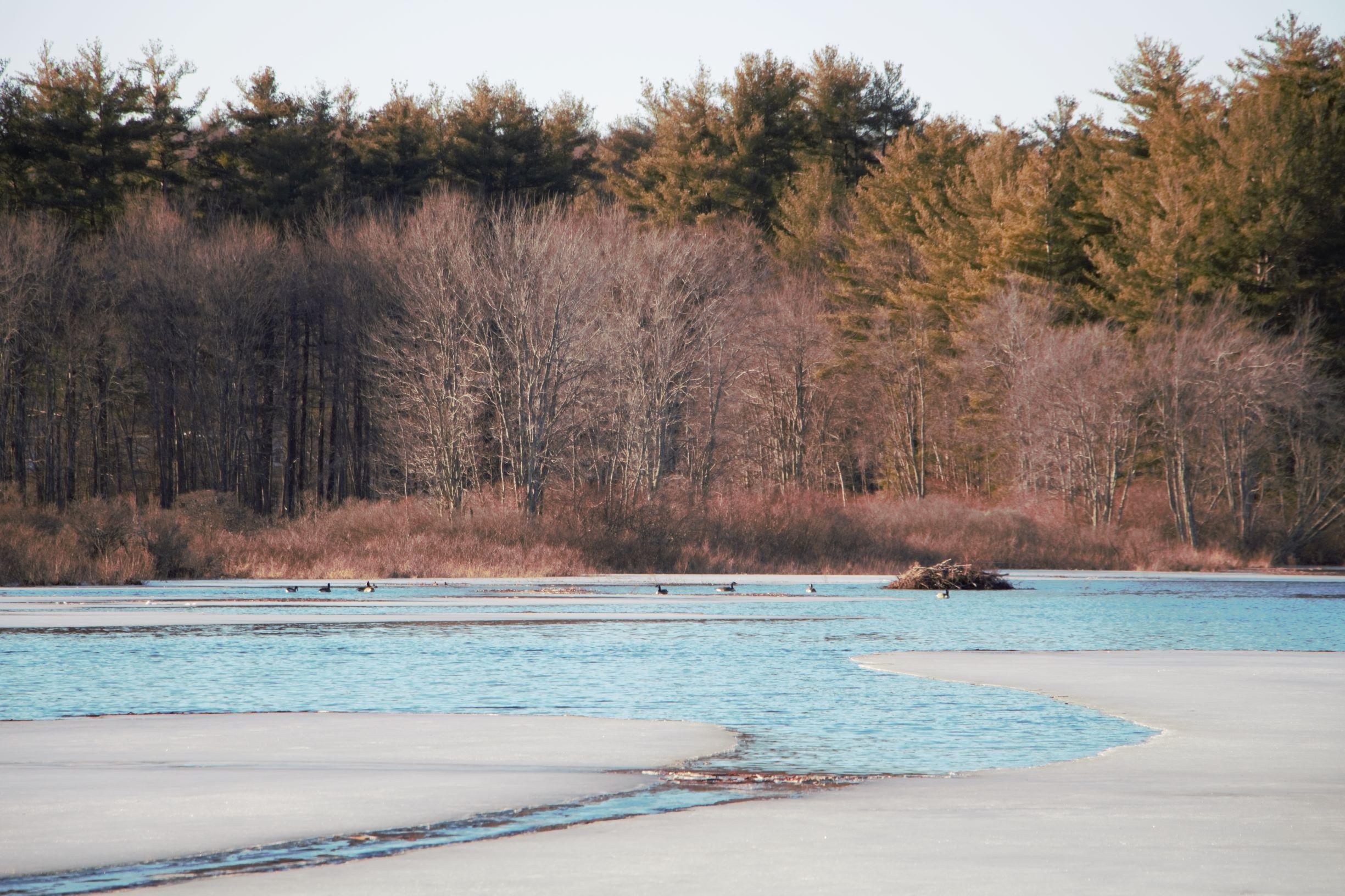- Tags:
- Something Wild,
- Climate,
- Clean Water

Ice in early spring on Lake Massabesic in Manchester.
This year, “ice in” on Lake Winnipesaukee wasn’t declared until Feb. 9, the latest date on record. And "ice out" was the earliest ever, March 17. That’s less than six weeks frozen.
So how does ice benefit our lakes?
It’s miraculous how ice forms.
“At 39 degrees the water molecules actually spread apart," explains Andrea LaMoreaux, an aquatic biologist and president of NH Lakes. "And then that layer of water on the top of the lake, which is around 39 degrees, becomes less dense than the water beneath it, so it floats. And what happens then is the surface keeps getting colder and colder, and at 32 degrees it forms ice.”
Nothing else in nature gets less dense as it freezes! Solids are typically more dense than liquids. And because ice is less dense than water, life can continue under the ice for fish, plankton, turtles and frogs, at a much slower metabolic pace, of course.
If you’ve ever jumped into a New Hampshire lake, you’ve felt how cold it is at the bottom, with warmer layers on top. That’s thanks to lakes freezing in the winter and then melting in the spring, which gives lakes a chance to turnover twice a year in spring and fall.
With the onset of colder temperatures in the fall, the surface water starts to cool. The temperatures at the top and bottom eventually equalize, and the lake starts to mix — the water on the bottom comes up and the surface water sinks down.
This mixing allows oxygen and nutrients to be distributed evenly and creates a seasonal cycle both fall and spring. Amy Smagula, a freshwater biologist and limnologist with the Department of Environmental Services, explains why turnover is important for lake health.
“Biologists tend to think of the winter as a reset for our lakes,” Smagula says. “So the mixing redistributes the nutrients in the fall. And then we go into this colder, darker period in the winter with ice cover where the lake is metabolically slower so you don't have as much algal production. You don't have plants growing. The animals are moving a little bit slower, so it's sort of a fresh start once we get into spring for the lake to reset itself.”
Those stratified layers make it possible for trout and salmon, which need cold water and high oxygen levels to dive down to the deeper, colder water in the summer.
“If we have a lot of productivity that's decreasing the oxygen, that deeper, colder water isn't going to have enough oxygen for them to survive,” Smagula says.
Ice acts as an insulator, reflecting sunlight so water at the bottom stays dark and cold. As lakes warm, we can expect more aquatic plants growing for longer periods of time.
A longer growing season? That means more algae. And warmer water favors more invasive plants, like milfoil, as well as cyanobacteria, also known as blue-green algae, a toxic bacteria that’s already become a problem in New Hampshire lakes.
But if you’ve got more algae and plants, aren’t they producing food and oxygen for fish and reptiles? Smagula says warmer water actually holds less oxygen.
“They could be producing it, but the water is not holding it," she says. "So things with gills that need to take oxygen out of the water, like fish, are going to have a hard time getting the oxygen that they need in those systems.”
There’s a phenomenon known as "lake browning" as the water column becomes more opaque with suspended organic material.
In recent summers, lake temperatures have been measured as high as 82 degrees. Two decades ago, summer high water temps were 72 to 74 degrees.
Warmer water with less dissolved oxygen obviously affects amphibians and fish, particularly the trout and salmon adapted to cold northern lakes. Fish also depend on aquatic insects and the intricate seasonal timing of hatch cycles of midges, caddis flies, stoneflies and mayflies.
Fish that are laying their eggs to hatch in a certain time interval — to line up with feeding different ages and stages of fish — could also be influenced, Smagula says.
"So all of these are cascading effects down the food web," she says.
Colder temperatures let migratory birds know it’s time to fly south, but if aquatic plants have a longer growing season without cold and ice, it’s possible that waterfowl might stick around longer.
Canada geese in particular are capable of overloading smaller lakes and ponds with nutrient fertilizer.
Bathwater temperatures may make it easier to dive into, but it’s a symptom of why we need to do whatever we can to mitigate warming water.
Literally and figuratively, we’re skating on thin ice. Ice cover itself is a crucial part of our living lakes. Ice makes it possible to sustain not only the traditional winter “ice-based” tourism in northern New England, but also supports the plants and animals that depend on our cold lakes and forested watersheds.
Thanks to Amy Smagula of New Hampshire Department of Environmental Services and Andrea LaMoreaux of NH Lakes for helping us to better appreciate the benefits of lake ice.
Something Wild is a partnership of the Forest Society, NH Audubon, and NHPR.
